
A watch is a timepiece carried or worn by a person. It is designed to keep a consistent movement despite the motions caused by the person's activities. A wristwatch is designed to be worn around the wrist, attached by a watch strap or other type of bracelet, including metal bands or leather straps. A pocket watch is carried in a pocket, often attached to a chain. A stopwatch is a watch that measures intervals of time.

Casio Computer Co., Ltd. is a Japanese multinational electronics manufacturing corporation headquartered in Shibuya, Tokyo, Japan. Its products include calculators, mobile phones, digital cameras, electronic musical instruments, and analogue and digital watches. It was founded in 1946, and in 1957 introduced the first entirely compact electronic calculator. It was an early digital camera innovator, and during the 1980s and 1990s, the company developed numerous affordable home electronic keyboards for musicians along with introducing the first mass-produced digital watches.

A pocket watch is a watch that is made to be carried in a pocket, as opposed to a wristwatch, which is strapped to the wrist.

Seiko Group Corporation, commonly known as Seiko, is a Japanese maker of watches, clocks, electronic devices, semiconductors, jewelry, and optical products. Founded in 1881 by Kintarō Hattori in Tokyo, Seiko introduced the world's first commercial quartz wristwatch in 1969.

Swatch is a Swiss watch company founded in 1983 by Ernst Thomke, Elmar Mock, and Jacques Müller. It is a subsidiary of The Swatch Group. The Swatch product line was developed as a response to the "quartz crisis" of the 1970s and 1980s, in which inexpensive, battery-powered, quartz-regulated watches were competing against more established European watchmakers focused on artisanal craftsmanship producing mostly mechanical watches.
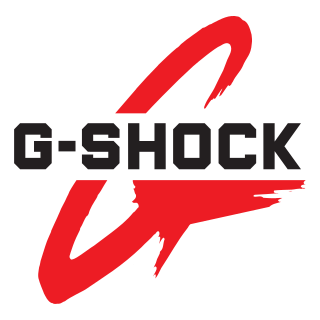
The G-Shock is a line of watches manufactured by the Japanese electronics company Casio, designed to resist mechanical stress, shock and vibration. G-Shock is an abbreviation for Gravitational Shock. The watches in the G-Shock line are designed primarily for sports, military and outdoors-oriented activities; all G-Shocks have a chronograph feature, 200 metre water resistance and an alarm, with either a digital display, analogue display or a combination of analogue and digital displays. Other features such as a countdown timer, world clock, and a backlight are included in most models. Newer high-end models in the line also feature GPS, directional, pressure and temperature sensors, radio-controlled time adjustment and Bluetooth time adjustment achieved by connecting the watch to a smartphone via a dedicated application.

Eco-Drive is a model range of watches manufactured and marketed worldwide by Citizen Watch Co., Ltd., powered primarily by light. As of 2007, the company estimated the drive system had eliminated the disposal of ten million batteries in North America.

A solar-powered watch or light-powered watch is a watch that is powered entirely or partly by a solar cell.

Citizen Watch Co., Ltd., also known as the Citizen Group, is an electronics company primarily known for its watches and is the core company of a Japanese global corporate group based in Nishitokyo, Tokyo, Japan. In addition to Citizen brand watches, it is the parent of American watch company Bulova. Beyond watches, Citizen also manufactures calculators, printers, health care devices, and precision CNC machining equipment.

A digital clock displays the time digitally, as opposed to an analogue clock.

The history of watches began in 16th-century Europe, where watches evolved from portable spring-driven clocks, which first appeared in the 15th century.
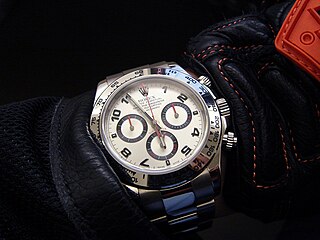
The Rolex Cosmograph Daytona is a mechanical chronograph wristwatch designed to meet the needs of racing drivers by measuring elapsed time and calculating average speed. Its name refers to Daytona, Florida, where racing flourished in the early 20th century. It has been manufactured by Rolex since 1963 in four distinct generations ; the second series was introduced in 1988, the third in 2000 and the fourth in 2023. While cosmetically similar, the second series introduced a self-winding movement, and the third series brought manufacture of the movement in-house to Rolex.

Indiglo is a product feature on watches marketed by Timex, incorporating an electroluminescent panel as a backlight for even illumination of the watch dial.
The Master of G is a line of G-Shock watches produced by Japanese electronics company Casio designed for usage in harsh environments. Many showcase new technology that Casio would eventually introduce into the G-Shock line of watches, such as an altimeter, digital compass and the Tough Solar feature.
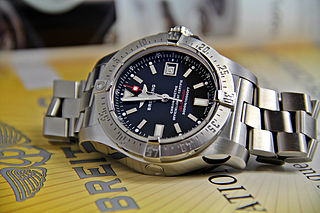
A diving watch, also commonly referred to as a diver's or dive watch, is a watch designed for underwater diving that features, as a minimum, a water resistance greater than 1.1 MPa (11 atm), the equivalent of 100 m (330 ft). The typical diver's watch will have a water resistance of around 200 to 300 m, though modern technology allows the creation of diving watches that can go much deeper. A true contemporary diver's watch is in accordance with the ISO 6425 standard, which defines test standards and features for watches suitable for diving with underwater breathing apparatus in depths of 100 m (330 ft) or more. Watches conforming to ISO 6425 are marked with the word DIVER'S to distinguish ISO 6425 conformant diving watches from watches that might not be suitable for actual scuba diving.
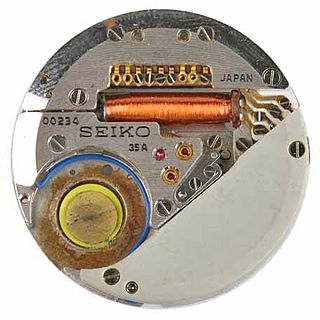
The quartz crisis (Swiss) or quartz revolution was the advancement in the watchmaking industry caused by the advent of quartz watches in the 1970s and early 1980s, that largely replaced mechanical watches around the world. It caused a significant decline of the Swiss watchmaking industry, which chose to remain focused on traditional mechanical watches, while the majority of the world's watch production shifted to Japanese companies such as Seiko, Citizen and Casio which embraced the new electronic technology. The strategy employed by Swiss makers was to call this revolution a 'crisis' thereby downgrading the advancement from Japanese brands.
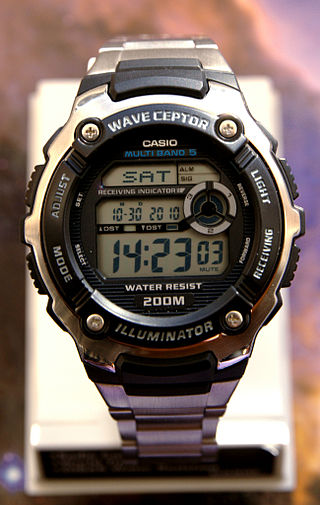
The Wave Ceptor series is a line of radio-controlled watches by Casio. Wave Ceptor watches synchronise with radio time signals broadcast by various government time services around the world. These signals transmit the time measured by atomic clocks accurate to one second in millions of years. By synchronizing daily with the signals, the Wave Ceptor watches achieve high accuracy, using a quartz crystal to keep time in the interim. Some radio watches, including some Wave Ceptors, are solar-powered, supported by a rechargeable battery. The watch displays may be fully digital, analog, or analog-digital. Hybrid Wave Ceptor models support GPS satellite reception of both time and location, in addition to broadcast signals.
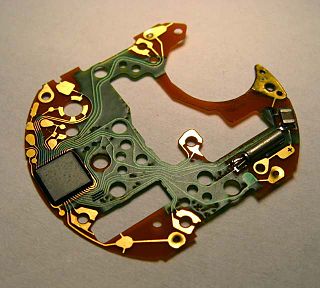
Quartz clocks and quartz watches are timepieces that use an electronic oscillator regulated by a quartz crystal to keep time. This crystal oscillator creates a signal with very precise frequency, so that quartz clocks and watches are at least an order of magnitude more accurate than mechanical clocks. Generally, some form of digital logic counts the cycles of this signal and provides a numerical time display, usually in units of hours, minutes, and seconds.

Edifice are a brand of watches manufactured by the Japanese electronics company Casio. The Edifice watches are designed to attract buyers engaged in professional careers. The watches have multiple functions, ranging from multiple dials to world time and multiple alarms.

The TX Watch Company was launched in 2006 by the Timex Group, an international holding group and corporate parent of global watchmaking companies, including Timex Group USA, Inc., TMX Philippines, Inc., and Timex Group India Ltd.


















